Top Voice Microphones for Every Use Case in 2023
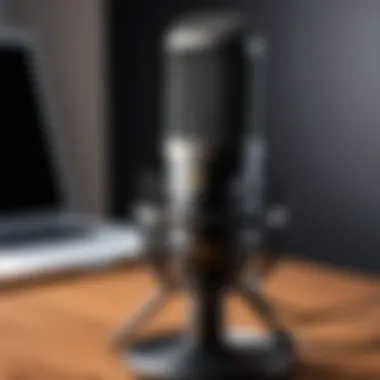
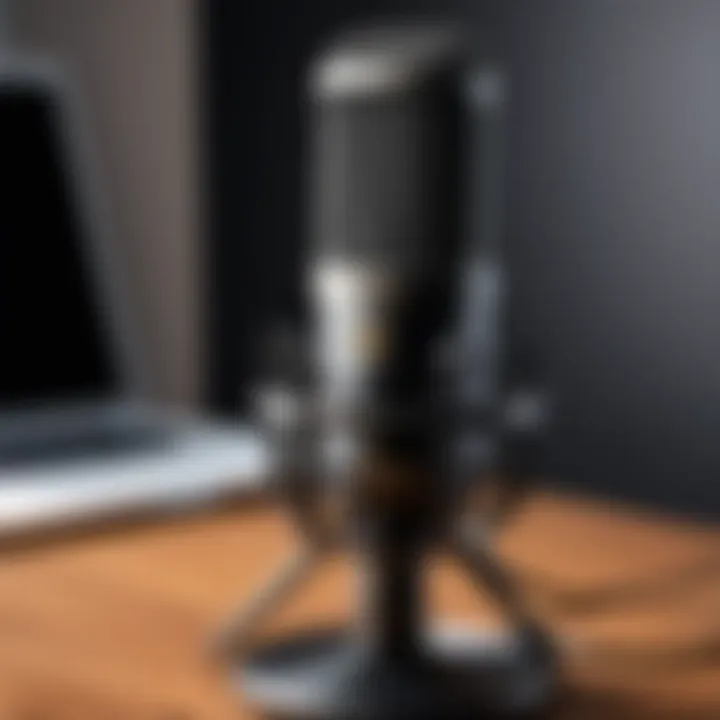
Intro
When it comes to voice microphones, the options appear almost endless. Every type and brand seems to promise crystal-clear audio, from podcasting to professional music recording. With the rise of gaming and live streaming, the demand for high-quality voice recording devices has never been more pronounced. Whether you're a podcaster looking to narrate your next great adventure or a team member in an esports tournament needing that edge, it all boils down to one crucial component: the microphone. In this article, we will explore the best voice microphones tailored for a range of applications.
We will examine microphone types, unique features, and performance metrics crucial for making a sound investment. By the end, readers should have a comprehensive understanding of what makes a microphone not just good, but the perfect fit for their specific needs. Let's take a closer look at how modern technology has shaped the landscape of voice microphones today.
Understanding Microphone Fundamentals
Understanding microphone fundamentals lays the groundwork for comprehending how various microphones function and their implications for different applications. Microphones are not merely tools to capture sound; they embody intricate technologies that convert sound waves into electrical signals. Grasping the basic operating principles of microphones is crucial for anyone looking to enhance their audio experience, whether in podcasting, gaming, or professional recordings.
What is a Microphone?
At its core, a microphone is a device that translates sound vibrations into electrical signals. When you speak or produce sounds near a microphone, it picks up those waves and transmits them in a form that can be amplified or recorded. Different types of microphones serve varied purposes, each with its distinct mechanisms and ideal environments for use. For instance, instruments capturing their own tonal subtleties require microphones that can respond accurately to their frequencies.
Types of Microphones
Microphones come in several varieties, each tailored to specific needs and environments. Let's dive deeper into the most common types:
Dynamic Microphones
Dynamic microphones are known for their resilience and versatility. They operate using a diaphragm that moves within a magnetic field, generating an electrical signal. This design makes them particularly robust, capable of handling high sound pressure levels, making them ideal for live performances.
A key characteristic of dynamic microphones is their ability to reject ambient noise, which is a huge plus in loud environments. For someone looking for reliability during a concert or public speaking, this characteristic can be invaluable, as dynamic mics like the Shure SM58 are quite a staple in the industry. However, one ought to note that they generally have a limited frequency response which might not capture the subtle details often needed for studio recordings.
Condenser Microphones
In contrast, condenser microphones excel in capturing nuanced sounds. This type utilizes a thin diaphragm placed close to a backplate, effectively creating a capacitor. They need a power source, often provided by a battery or phantom power from an audio interface, which allows them to pick up a wider frequency range and greater detail compared to dynamic microphones.
Condenser mics, like the Audio-Technica AT2020, shine in studio settings where clarity is paramount. Their sensitive nature makes them well-suited for vocals and acoustic instruments. A downside, however, is that they tend to be more delicate and can pick up more background noise, making them less ideal for live performance situations.
Ribbon Microphones
Ribbon microphones stand out with their vintage charm. They utilize a thin metal ribbon suspended in a magnetic field to produce sound. This unique design lends them warm, natural sonic qualities that many professionals adore.
Their classic tonal character can be especially appealing for capturing vocals and brass instruments. The downside to ribbon microphones is their fragility; they are not usually designed to handle high sound pressure levels which can lead to damage. Despite this, artists in search of that classic warmth often keep ribbon microphones in their toolkit for specific applications.
Lavalier Microphones
Lavalier microphones, small and discreet, are designed for hands-free use. These tiny mics are clipped to the speaker's clothing, providing excellent mobility. Given their size, they are commonly used in interviews, television production, and presentations.
The main advantage of lavalier microphones is their unobtrusiveness, allowing speakers to move freely while capturing consistent audio. However, they do require careful placement to avoid rustling noise and might not deliver the same richness of sound as larger microphone types.
USB Microphones
USB microphones offer a bridge between traditional recording setups and convenience. These plug-and-play devices connect directly to computers, making them a popular choice for podcasters and streamers. They contain built-in analog-to-digital converters, simplifying the recording process significantly.
Like the Blue Yeti, USB microphones provide solid audio quality and user-friendliness. However, they often lack the professional features found in XLR microphones, leading them to be an excellent choice for beginners or casual users, but perhaps not for those requiring extensive control over their sound.
Understanding these various types of microphones and their functionalities is key to selecting the right one for your needs. Evaluating your specific use case—be it professional recording or casual streaming—is essential to making an informed decision.
Criteria for Selecting the Best Voice Microphone
When it comes to choosing the right voice microphone, it’s not just about grabbing the first shiny piece of tech you see. Different microphones serve different purposes, and understanding the criteria behind their selection is crucial to maximizing sound quality and achieving desired outcomes in various application contexts. This section dives into specific elements, benefits, and considerations related to the criteria for selecting the best voice microphone.
Frequency Response
Frequency response measures the range of frequencies that a microphone can capture. It matters greatly because a microphone that captures a broader frequency range can reproduce sounds more accurately. For instance, vocals have a core range typically between 85 Hz to 255 Hz, but nuances can extend beyond that, making it vital for microphones to cover these frequencies to preserve the quality of voice.
When selecting a microphone, you want to ensure it accommodates your needs. For musicians, a wider range might be necessary to capture all vocal subtleties. In contrast, for podcasters focusing mainly on speech, a narrower range might suffice. A microphone with a flat frequency response curve is usually preferable, as it does not add color to the sound, letting your voice shine through as it is.
Polar Patterns
Cardioid
Cardioid microphones pick up sound primarily from the front, making them an excellent choice for solo applications. This pattern helps minimize background noise, ensuring that the microphone captures vocals without interference. The primary advantage of the cardioid pattern is its focus; it naturally rejects sounds from the sides and rear. However, if you’re not careful with positioning, you might lose some details if you move too far off-axis.
Omnidirectional
In contrast, omnidirectional microphones capture sound from all directions. This characteristic makes them versatile for situations where multiple voices or ambient sounds are beneficial, like live interviews or group discussions. The key aspect here is its ability to capture a fuller soundscape. However, it’s worth noting that omnidirectional mics can also pick up unwanted noises, which can become problematic in less controlled environments.
Bidirectional
Bidirectional microphones, as the name suggests, capture sound from the front and rear but reject sound from the sides. This design allows for engaging two people facing each other, making it a go-to choice for interviews. While it does a stellar job at capturing back-and-forth conversations, one must be mindful of background noise as the sides are less shielded compared to a cardioid.
Sensitivity and Output Levels
Sensitivity determines how well a microphone can detect sound levels—essentially, how quiet a sound can be before the microphone picks it up. Choosing the right sensitivity can make a world of difference. For instance, if you're in a controlled studio setting, high-sensitivity microphones can pick up soft vocals that might otherwise go unnoticed. However, in a lively environment, such as live streaming or gaming, a microphone with moderate sensitivity could help filter out unwanted background noise.
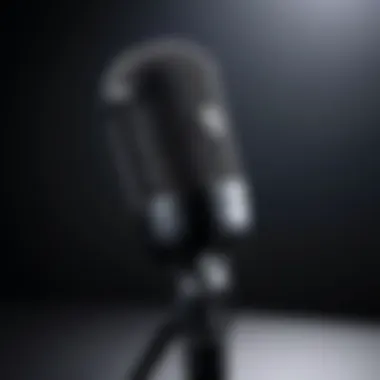
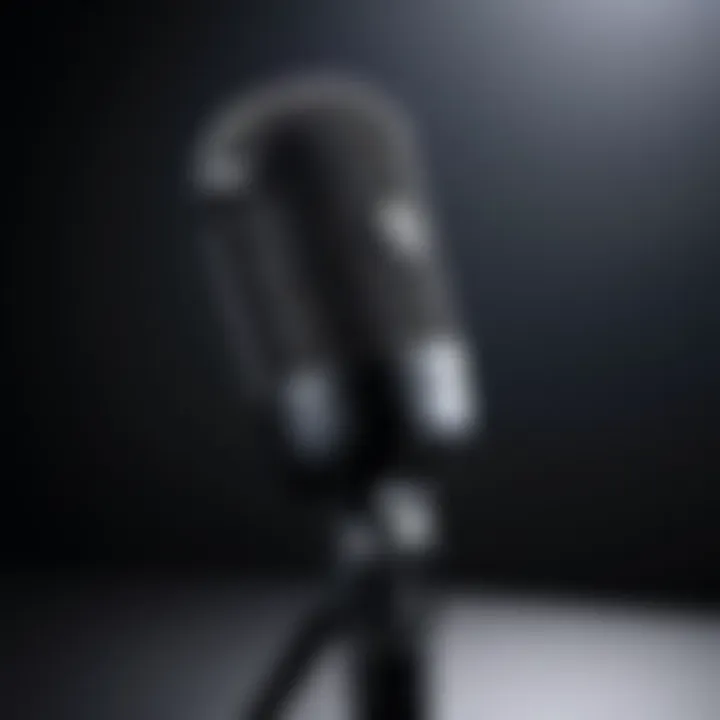
Increasing output levels is another critical aspect to consider. The microphone must be compatible with your recording device's input levels, avoiding distortion. An ideal microphone not only accepts a variety of sound pressure levels but also communicates seamlessly with your audio interface, yielding gadgets that perform harmoniously together.
Build Quality and Durability
Lastly, don't underestimate the importance of build quality and durability. Whether you're taking your microphone on the road for gigs or setting it up for a meticulous studio session, you need a microphone that can handle wear and tear. A solid body can withstand the rigors of everyday use, while internal components made from quality materials ensure longevity.
Additionally, features like shock mounts and pop filters can further enhance the durability and usability of your microphone. It’s wise to consider how often you’ll be transporting the microphone and what level of care you'll be able to provide—optimal choices can vastly impact the microphone's lifespan.
In summary, understanding these criteria lays the foundation for selecting a voice microphone that best suits your specific requirements, ultimately enhancing your audio quality and user experience.
Best Voice Microphones for Podcasting
Podcasting has become an important avenue for sharing ideas and stories. It’s not just about speaking into a microphone; the quality of the microphone amplifies the message. The right microphone can make the difference between a broadcast that engages the audience and one that falls flat. With listeners tuning in from various devices, the clarity and richness of the audio matters more than ever. Selecting a microphone tailored for podcasting involves understanding specific elements: how it responds to voice frequencies, how background noise is minimized, and how it plays into the overall production value. Choosing wisely here is crucial for both amateur and seasoned podcasters alike.
Top Recommendations
Shure SM7B
The Shure SM7B is often dubbed the 'gold standard' in podcast microphones. It's a dynamic microphone that is revered for its warm sound profile and versatility. Notably, it excels at capturing the nuances of the human voice, making it perfect for storytelling environments. One standout characteristic of the SM7B is its built-in air suspension system, which drastically reduces unwanted mechanical noise. This microphone is favored for its adaptability across various sound sources, be it a quiet voice or a louder shout. However, it may demand a robust audio interface due to its relatively low output level.
Audio-Technica AT2020
Audio-Technica AT2020 is renowned for its budget-friendly design alongside impressive sound quality. Featuring a cardioid polar pattern, it effectively minimizes background noise, which is a game-changer for home studios. The clarity it brings to spoken word content cannot be underscored enough. Its solid build ensures long-lasting durability, making it ideal for podcasters on the move. One unique aspect of the AT2020 is its low self-noise, which means you get a cleaner and clearer recording without needing extensive post-production fixes.
Rode NT1
The Rode NT1 is noted for its extreme sensitivity and wide frequency range. It captures subtle sounds with striking detail, which is particularly beneficial for podcasters looking to produce a polished product. Its standout feature is the incredibly low self-noise level, often quoted as the quietest in the world of studio microphones. This characteristic allows for capturing even the quietest whispers without hassle. However, it’s important to have a well-controlled recording environment, as its sensitivity can also pick up unwanted sounds.
Key Features to Consider
When searching for the best voice microphone for podcasting, certain features rise to the top, making them critical in your decision-making process:
- Frequency response: Look for a microphone that captures the full range of your voice without coloring the sound.
- Polar pattern: A cardioid pattern is usually best for podcasting as it focuses on the sound in front while rejecting background noise.
- Durability: Your equipment should withstand travel and frequent use, so consider build quality here.
- Accessories: Included pop filters or shock mounts can enhance overall sound quality.
- Price: Finding a good balance between budget and performance is essential to ensure longevity and quality in audio production.
Outstanding Microphones for Gaming
In the realm of gaming, having a reliable and clear communication channel can elevate the experience tremendously. Whether you're strategizing with teammates during a multiplayer match or broadcasting your gameplay to an audience, the microphone plays a pivotal role. It ensures the immersion is not just in the visuals but in the audio quality as well. A good gaming microphone doesn't just enhance voice clarity; it can also filter out background noise, which is crucial in a competitive environment. As we dive into the specifics, keep in mind the elements that make a gaming microphone stand out—those include sound clarity, ease of setup, and unique features tailored to gamers.
Leading Picks
HyperX QuadCast
The HyperX QuadCast is a standout player in the gaming microphone scene. One significant aspect of this microphone is its built-in anti-vibration shock mount. This provides an excellent advantage by minimizing unwanted noise from movements or bumps, ensuring your voice comes through clearly. A key characteristic that makes the HyperX QuadCast beneficial for gamers is its four selectable polar patterns: cardioid, omnidirectional, bidirectional, and stereo. This versatility allows users to adjust the microphone setup based on their specific gaming environments or needs. Moreover, one standout feature is its anti-pop filter, which greatly reduces plosive sounds, ultimately enhancing the voice quality. However, while its features are impressive, its bulkiness can be a consideration for those with limited desk space.
Blue Yeti
The Blue Yeti is in many ways the jack-of-all-trades when it goes to gaming microphones. One of the specific aspects that this microphone excels in is its simplicity of use. With its plug-and-play functionality, even novice gamers can jump right in without hassle. A key characteristic that makes the Blue Yeti a popular choice is its tri-capsule technology, which allows for various recording modes—stereo, cardioid, omnidirectional, and bidirectional. There’s a unique dial on the microphone that lets users adjust the gain, making it customizable for different gaming environments. Still, the microphone's size might present a challenge for those who prefer a more low-profile look, and it can be susceptible to picking up unwanted background noise.
Razer Seiren
The Razer Seiren X shines brightly with its compact design and purposefully built features for gamers. One specific aspect that stands out is its ultra-low latency monitoring. This feature allows gamers to hear their voice in real-time without any delay, aiding in precise communication. A key characteristic that makes this microphone favorable is its supercardioid pickup pattern, designed to capture sound directly in front while minimizing ambient noise. Its unique built-in shock mount further sets it apart by helping to reduce vibrations caused by desk movements. However, its focus on being compact could mean that it lacks some of the advanced features found in larger competitors.
Gaming-Specific Features
When it comes to gaming microphones, several features cater specifically to the needs of gamers. Here are some gaming-specific qualities to consider:
- Noise Cancelling: Effective noise cancellation is critical to ensure a crystal-clear voice.
- Real-Time Monitoring: The ability to hear oneself while speaking prevents shouting or mumbling.
- Customizable Polar Patterns: Flexibility in choosing how audio is captured enhances versatility based on gameplay sessions.
- Ease of Use: Simple plug-and-play setups allow gamers to get to gaming faster.
- Compatibility: It’s vital to ensure that the microphone works seamlessly with gaming consoles and computers.
Investing in the right microphone can dramatically enhance your gaming experience, improving not just your performance but also your communication with others.
In summary, among the myriad options available, the right gaming microphone can be the difference between victory and defeat, especially in high-stakes scenarios. Choosing one that meets your specific needs will provide the best balance between functionality and sound quality.
Microphones for Professional Recording
In the realm of audio production, choosing the right microphone can be the difference between a polished performance and an amateurish recording. Professional recording environments demand top-tier equipment that can capture sound with precision and clarity. Here, we delve into microphones designed for professionals who depend on sound quality to deliver their best work. These microphones not only enhance the fidelity of recordings but also provide flexibility for various applications, whether in a studio setting or for live events.
Best Choices
Neumann U87
The Neumann U87 is often seen as the gold standard in studio microphones. Known for its remarkable ability to capture vocals with warmth and clarity, it's a favorite among vocalists and sound engineers alike. One key characteristic of the U87 is its versatile polar patterns; it can operate in cardioid, omnidirectional, and bidirectional modes, allowing it to adapt to different recording needs.
A unique feature of this microphone is its low self-noise, which makes it ideal for capturing subtle nuances in soft vocals or instruments. However, this luxury comes at a price, as the Neumann U87 is on the higher end of the market, which might be a consideration for budgets.
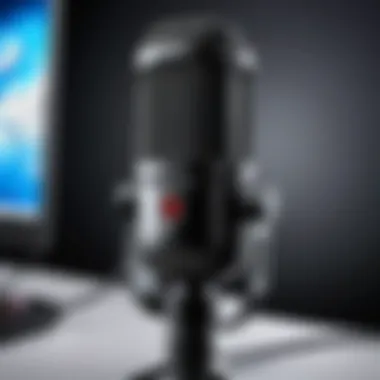

AKG C414
Next in line is the AKG C414, a microphone that has gained a lot of traction for its versatility and high-quality sound reproduction. This microphone’s key characteristic is its 9 selectable polar patterns. This flexibility ensures that it can handle a wide range of recording situations effectively.
The C414 features a switchable low-cut filter and a pad function that makes it well-suited for loud sound sources or close-miking instruments. One advantage is that it often comes at a slightly lower price than the U87, while still retaining the clarity and presence professionals desire. However, some might find it colored in terms of sound, which may not suit everyone’s taste.
Sennheiser MKH
Finally, the Sennheiser MKH 416 is a go-to choice for those in the film and broadcasting industries. This microphone is revered for its directional pickup pattern and its ability to isolate the subject's voice from background noise, a characteristic instrumental for clear audio capture in busy environments or field settings.
The unique feature of the MKH 416 is its high frequency response combined with low self-noise, producing crisp audio quality that lends itself well to dialogue recording. As for downsides, its somewhat higher price point can be off-putting for those just starting out, but its performance is often cited as worth the investment.
Considerations for Studio Use
When selecting microphones for studio use, several factors come into play:
- Room Acoustics: The sound quality can vary significantly depending on room characteristics. Better acoustics yield better recordings.
- Microphone Placement: The position of microphones in relation to sound sources can drastically affect audio quality.
- Preamp Quality: The quality of the microphone preamplifier enhances the sound captured by the mic. A more expensive mic paired with a subpar preamp may not perform to its full potential.
Ultimately, understanding these considerations can help users maximize their microphone's effectiveness, ensuring professional results every time.
Portability and Versatility in Microphones
Portability and versatility are key attributes that play a pivotal role in the decision-making process for any individual or organization looking to purchase a microphone. Gone are the days when one could rely solely on traditional, stationary setups. Today, the demands of content creation, whether it's podcasting, gaming, or even a live performance, demand microphones that can easily adapt to different environments and needs. Having a portable microphone can be the difference between a fleeting thought captured or a missed opportunity.
When we think about portability, we need to consider how easily a microphone can be transported. Something that can fit snugly in a backpack without adding much weight is a huge plus, especially for those who travel extensively. Lightweight models such as the Shure MV5 or the Rode SmartLav+ offer incredible functionality without the hassle of dragging around bulky equipment.
Versatility, on the other hand, encompasses the microphone's ability to be used in various settings – think about how it performs in different acoustical environments. A microphone that can function well in a quiet studio as well as in a bustling café or outdoors can serve a multitude of purposes, thus answering the call of many users.
"The best microphone is the one that suits the task at hand, no matter where you are."
The balance between portability and versatility often means that users may have to compromise on some features, but the right choice can still yield excellent results. With the ever-increasing popularity of streaming and content creation from non-traditional settings, these characteristics are as important as ever.
Travel-Friendly Models
When diving into travel-friendly models, one might consider factors beyond just size and weight. Features like durability, ease of setup, and sound quality are equally vital. For example, the Zoom n Handy Recorder is compact and provides great audio while being simple enough for anyone to use, making it an ideal option for on-the-go creators.
Additionally, models like the Rode NT-USB Mini are designed with built-in mounting capabilities, making them straightforward to attach to any surface — also a boon for those who want less fuss when setting up their recordings on the run. The convenience of USB connectivity allows for easy plug-and-play functionality which is paramount in cord-cutting, fast-paced contexts.
Multi-Use Microphones
The concept of a multi-use microphone transcends basic expectations. These microphones are truly versatile and can perform admirably across numerous scenarios. The Audio-Technica AT2020 is an excellent case in point. It serves well for recording vocals and instruments alike, making it a valuable investment for budding musicians and streamers trying their hand at different types of content.
Moreover, the ability to switch polar patterns can enhance its use. Choosing a microphone like the Rode NT-1 provides options for cardioid or omnidirectional patterns, which enables users to adapt their equipment to specific recording environments – be it solo vocals or group discussions.
In the realm of gaming, having the flexibility to use one microphone for streaming, dialogue, and gaming sessions can simplify the equipment choices greatly. With quality sound capturing along with portability, these multi-use microphones generate easy setup, making them perfect for varied applications whether at home, or elsewhere.
Therefore, investing in portable and versatile microphones not only enhances user experience but also ensures that you remain adaptable to whatever acoustic challenges may come your way.
Wired vs. Wireless Microphones
When it comes to choosing between wired and wireless microphones, understanding the nuances of each can markedly affect your audio experience. Both types offer unique benefits and drawbacks that cater to different situations, whether you're a podcaster, gamer, or professional sound engineer. This section dives deep into the characteristics of these microphone types, allowing users to consider what aligns best with their needs and preferences.
Advantages and Disadvantages
Wired Microphones
Wired microphones are often seen as the stalwart of audio equipment. Their reliability stands out, especially in professional settings where sound quality is paramount. Here are some key advantages:
- Superior Signal Quality: Wired mics deliver cleaner audio since they are not susceptible to interference that can plague wireless systems.
- No Batteries Needed: Forget about the anxiety of your microphone battery dying mid-session. Wired models provide a consistent power source.
- Less Latency: Wired setups typically have lower latency issues, critical for live performances where timing is everything.
However, they come with their own set of downsides:
- Limited Mobility: The necessity of a cable can constrain movement, which may be a concern for dynamic uses.
- Setup Complexity: Depending on the environment, managing cables can become a chaotic task.
Wireless Microphones
On the flip side, wireless microphones are celebrated for their versatility. Here are some of the advantages:
- Freedom of Movement: Perfect for performers and speakers needing to move around without being tethered.
- Easier Setup: Fewer cords lead to a quicker, cleaner setup.
But, it’s critical to consider the limitations:
- Signal Interference: Other electronic devices can cause disruptions in the audio signal, especially in crowded spaces.
- Battery Dependency: Running out of battery can spell disaster in live situations, necessitating regular checks or replacements.
Use Cases for Each Type
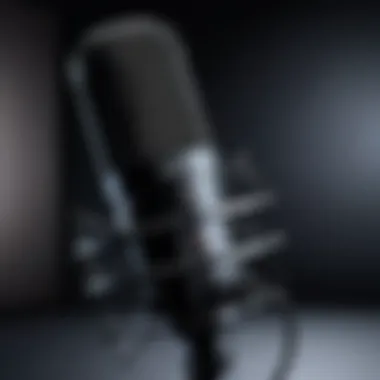

Choosing between wired and wireless microphones often relies on the specific context of use.
- Wired Microphones are ideal for:
- Wireless Microphones shine in:
- Studio Recording: Where sound purity and reliability are non-negotiable, like using a Neumann U87 for vocals.
- Broadcasting: Ensuring clear audio in controlled environments, such as radio stations.
- Live Performances: Musicians who need to roam on stage, like during concerts where flexibility is key.
- Speeches and Presentations: Speakers at conferences often prefer wireless for greater engagement with their audience.
In summary, the choice between wired and wireless microphones hinges on understanding their respective advantages, disadvantages, and ideal use cases. Whether you favor a wired setup for its steadfastness or lean towards wireless for its freedom, making an informed decision will undoubtedly enhance your overall audio experience.
Enhancing Audio Quality with Accessories
When it comes to achieving a polished and professional sound, simply having a high-quality microphone isn’t enough. The nuances of audio recording can often hinge upon the accessories that accompany your microphone setup. Enhancing audio quality through accessories is a pivotal aspect in ensuring that the final output meets the desired standards. The right tools can bridge the gap between average sound and extraordinary sound, catering to those who demand the best from their audio equipment.
Microphone Stands and Mounts
Stability is often the unsung hero of modren audio setups. Microphone stands and mounts are critical for maintaining a steady position, minimizing unwanted noise that could arise from handling or environmental vibrations. Whether you opt for a desk stand or a boom arm depends on your specific setting and application. For instance, podcasters might lean towards boom arms as they provide flexibility in positioning, while live streamers might prefer traditional desk mounts that offer firm footing.
Moreover, the height adjustability and tilt features enable sound engineers to pinpoint the best distance from the speaker, which is crucial in achieving an ideal sound capture. When choosing a stand or mount, consider the weight of your microphone, as an insufficient stand could lead to unfortunate drooping or topppling. Look for sturdy materials that promise longevity, especially in a professional environment where equipment may see heavy use.
Pop Filters and Windshields
Next on the list are pop filters and windshields. These accessories play a monumental role in the battle against unwanted noises. Pop filters work by diffusing plosives, those sudden burst sounds that can distort recordings, especially with dynamic microphones. It’s not just about avoiding distracting pops; it is about preserving the overall clarity and integrity of your voice. Think of pop filters as your sound's first line of defense, absorbing intense air pressure from speech sounds.
On the other hand, windshields come into play primarily in outdoor settings or when recording in less controlled environments. They shield microphones from wind noise, which can be a nuisance when trying to capture a clear audio signal. Both tools are easy to implement, often inexpensive, yet they make a drastic difference in the final product. Many users find these accessories not only extend the life of their microphones but also enhance sound quality more significantly than expected.
Audio Interfaces and Mixers
The role of audio interfaces and mixers cannot be understated in an audio production setup. An audio interface serves as a bridge between your microphone and computer, converting analog signals into digital form. It can significantly impact sound quality, as a cheap interface may introduce noise and muddiness that overshadows the clarity that a good mic can deliver. Look for interfaces with higher sample rates and bit depths, as these specifications determine the fidelity of the recording.
Mixers, on the other hand, provide flexibility in sound shaping. Users can adjust levels, add effects, or even blend multiple audio sources. With a mixer at your disposal, you gain the advantage of manipulating individual sounds to achieve the perfect blend for your recording or live stream. Whether it’s subtle adjustments to create depth or managing the levels between multiple microphones, a mixer enriches the audio landscape, making every recording feel professional.
"Investing in quality accessories not only optimizes the performance of your microphone but also elevates the overall audio experience."
In the grand scheme of voice recording and broadcasting, the importance of enhancing audio quality with appropriate accessories cannot be brushed aside. When you consider the equipment that best compliments your microphone, you're not just investing in tools; you're investing in the confidence of delivering crystal-clear audio that resonates with your audience.
Budget Considerations in Microphone Selection
Pricing plays a pivotal role in microphone selection, influencing not only the options available but also the overall experience for the user. For individuals diving into the world of podcasting, gaming, or professional recording, understanding the budget landscape can greatly enhance decision-making. Choosing a microphone isn't simply about finding the cheapest option; it’s about finding the right balance between quality and cost. As microphones come in a variety of price points, each range typically represents different features, build quality, and durability, often translating into an unequaled listening experience.
As consumers, we often face the saying, "You get what you pay for," which rings true in the microphone market. A well-crafted microphone that can capture the nuances of voice and sound will likely cost more, but will it meet the user's needs? The conversation about budget shouldn't shy away from considering what you intend to do with the microphone. Are you planning to use it casually every now and then, or are you looking to make a career out of sound production? Each scenario may warrant a different budget.
Additionally, it’s essential to consider lasting value. Cheaper options might save a few bucks upfront but could lead to higher dissatisfaction and eventual replacements down the road—alleviating your wallet in the long run. Let's peel back the layers and dive deeper into the price ranges and the essence of value versus performance.
Price Ranges Explained
Microphones can typically be categorized into three main price tiers: budget-friendly, mid-range, and premium.
- Budget-Friendly Microphones: These microphones, often between $30 to $100, can still deliver decent sound quality. Ideal for beginners or casual users, options in this range include models like the Audio-Technica ATR2100 or Fifine K669B. They may lack some advanced features but offer a good introduction to audio recording without breaking the bank.
- Mid-Range Microphones: Ranging from $100 to $300, these microphones often present a significant upgrade in materials and sound fidelity. Models such as the Rode NT-USB and the Blue Snowball can capture clearer sound, making them popular choices for budding podcasters and streamers.
- Premium Microphones: For those who are serious about audio, expect to invest $300 and above. These microphones, such as the Shure SM7B and Neumann U87, provide exceptional clarity and durability but at a more challenging price point. Often, they are used in professional studios and by experienced audio engineers.
Understanding these ranges can greatly influence your decision and help you weigh your options carefully based on your needs and priorities.
Value vs. Performance
When selecting a microphone, understanding the relationship between value and performance is crucial. The aim is to find a product that not only fits your financial constraints but also meets or exceeds your performance expectations. Here’s where savvy shoppers differentiate between mere cost and real value.
- Performance Features: Does the microphone have a broader frequency response that accurately captures the highs and lows? Are the polar patterns suitable for your environment? Mic performance should align with its intended use, whether that be music, podcasts, or gaming.
- Durability and Build Quality: A microphone's lifespan often justifies its cost. Durability is especially vital for portable or outdoor uses. If a lower-priced mic gives out after a year, the financial savings evaporate.
- User Experience: It’s essential to consider how easy it is to set up and use. Sometimes, features that seem appealing on paper may be anything but user-friendly during actual performance.
"The true value is discovered not just in the specs, but in how well a microphone adapts to your unique needs."
Ultimately, it’s a balancing act—aiming to find a microphone that offers both reasonable pricing and high-quality auditory performance. It’s well worth the time to research, test, and reflect on what each investment brings to the table. This way, users can ensure they make their hard-earned money work for them, without sacrificing on quality for the sake of a few bucks.
Ending
Navigating the world of voice microphones can often feel like wandering through a vast maze, filled with options and technical jargon that can leave even experienced users a tad bewildered. This article sought to demystify this landscape by laying down the fundamental components essential for selecting the right microphone for a variety of applications. In summarizing the insights, we identify key elements that make certain microphones stand out in their specific fields, whether it’s podcasting, gaming, or professional recording.
Summarizing Key Insights
When it comes to choosing a microphone, understanding the particular use case is crucial. For instance, podcasters often prioritize clarity and warmth in their audio, making models like the Shure SM7B a popular choice. In contrast, gamers may be drawn toward microphones like the HyperX QuadCast, which not only deliver excellent sound but also feature user-friendly aspects, like built-in pop filters and backlighting.
Furthermore, we highlighted considerations such as frequency response, polar patterns, and build quality. All these factors dramatically influence the overall audio experience. Moreover, insight into accessories like pop filters and dedicated microphone stands is vital as they can enhance even the most basic microphones to pro levels.
"The right microphone isn't just a tool; it’s a companion in your sonic journey, influencing how your voice is perceived and connecting you to your audience."
Final Recommendations
To wrap up, consider these factors before making a purchase:
- Identify Your Purpose: Think about whether you’ll be using your microphone mainly for podcasting, gaming, or recording. Each scenario demands different features.
- Invest in Quality: While budget is a concern, remember that a well-built microphone can last years, often making it a worthwhile investment.
- Test Before You Buy: If possible, try out different models to find one that feels right. The comfort, weight, and overall handling should feel natural to you.



